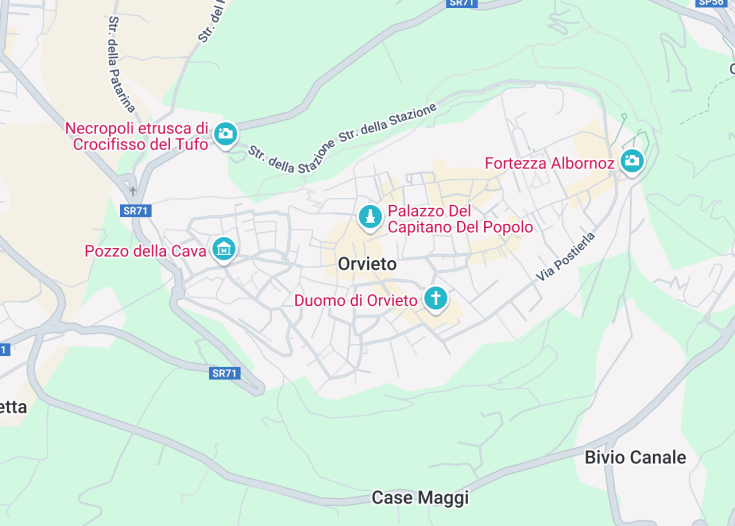Orvieto, an enchanting hilltop city in the heart of Italy’s Umbria region, boasts a rich blend of history, culture, and architectural marvels. Known for its magnificent 14th-century cathedral, which features a stunning facade and intricate frescoes by Luca Signorelli, Orvieto offers a unique glimpse into medieval Italy. The city’s ancient streets, underground tunnels, and surrounding vineyards add to its mysterious allure, making it a must-visit for history buffs and wine lovers alike. Its strategic location, perched on a volcanic tuff, provides breathtaking views of the Umbrian landscape.
When visiting Orvieto, make sure to explore the underground city. The labyrinthine tunnels offer a fascinating insight into Orvieto’s history and provide a unique perspective of the city.
Consider timing your visit to coincide with the ‘Città Slow’ Sunday market. It’s a wonderful opportunity to experience local culture, cuisine, and artisan crafts firsthand, enhancing your Orvieto experience.
Top things to do & see in Orvieto
Select the following sights and activities to discover best tickets and tours available in Orvieto.
Orvieto: The Jewel on the Cliff
| Country | Italy |
| Time in Orvieto | GMT+1 |
| Language spoken | Italian |
| Population | 20,692 (source: Istat, 2023) |
| Currency | Euro (€, EUR) |
| Airports |
|
Orvieto, Italy, a city set dramatically atop a volcanic plug, is a hidden treasure offering a glimpse into medieval Europe. Known for its breathtaking views and historical architecture, Orvieto is an encapsulation of the quintessential Italian charm. The city is adorned with a striking Gothic cathedral featuring a façade studded with mosaics and stained glass. Exploring Orvieto means walking through narrow, charming streets filled with stores selling local crafts, including the famed Orvieto ceramics and vibrant textiles.
Where is Orvieto?
Perched on a volcanic rock, Orvieto commands the Umbrian hilltop, offering panoramic views.
Distances:
| Route | Distance by car | Time by car |
|---|---|---|
| Rome to Orvieto | 80 miles | 1 hour 30 minutes |
| Florence to Orvieto | 99 miles | 2 hours |
| Naples to Orvieto | 186 miles | 3 hours 20 minutes |
What is Orvieto famous for?
Orvieto is renowned for its stunning Cathedral of Orvieto, an architectural masterpiece of Gothic design built in 1290. The city is also famous for its white wines, particularly the dry, crisp Orvieto Classico.
History
Orvieto, with its rich history stretching back over three millennia, is one of Italy’s most fascinating cities. Perched on a volcanic cliff, its history is as dramatic as its landscape.
Pre-Roman and Roman Period (9th Century BC – 5th Century AD)
The area of Orvieto was first settled by the Etruscans who were attracted to the site due to its defensible position and fertile volcanic soil. The Etruscans created a flourishing society, evidenced by the extensive necropolis and remnants of temples found in the vicinity. With the eventual expansion of the Roman Empire into the Etruscan territories during the 3rd century BC, Orvieto came under Roman control and continued to prosper as a significant urban center.
Medieval Period (5th Century – 15th Century)
After the fall of the Roman Empire, Orvieto became a commune in the medieval period. The city saw significant growth and was the site of fierce battles and sieges due to its strategic importance. Its impressive walls, built to ward off invaders, still stand today. During this period, Orvieto became a refuge for Popes, which enhanced its religious and political significance. The construction of its magnificent cathedral, which started in 1290, symbolizes this era of prosperity and religious devotion.
Renaissance and Modern Era (15th Century – Present)
Throughout the Renaissance, Orvieto continued to flourish as an artistic and cultural center. The city saw the construction of several beautiful palaces and was home to many prominent artists and architects. The modern era brought with it new challenges and changes, but Orvieto adapted by promoting its historical and architectural heritage, thus becoming a significant tourist destination. The city’s beauty and history continue to appeal to visitors from around the world, preserving its legacy as a center of art, culture, and history.
Visit Orvieto
What to see and do in Orvieto, Italy.
Explore the stunning Orvieto Cathedral, a masterpiece of Gothic architecture with its striking façade and richly decorated chapels. Venture down the St. Patrick’s Well, ingenious in its construction, designed to supply the city during sieges.
- Visit the underground city, a labyrinth of tunnels and caverns carved out over centuries.
- Enjoy local wines and cuisine in a traditional trattoria.
- Admire the views from the Torre del Moro, offering panoramic views of the city and the Umbrian countryside.
Festivals and events in Orvieto.
Orvieto hosts a variety of recurring events throughout the year which reflects its rich cultural heritage. Notable among them is the Orvieto Jazz Festival, held in December, attracting musicians and fans from around the globe. The summer months see the Umbria Jazz Festival, drawing international artists and audiences. Additionally, the medieval ‘Palio della Quintana’ re-enactment offers a glimpse into the city’s history with a competitive spirit, occurring in late spring.
Best time to visit Orvieto
The best time to visit Orvieto depends on personal preferences; spring and early autumn offer pleasant weather, fewer crowds, and the vibrant colors of the Umbrian landscape. Summer brings lively festivals and a bustling atmosphere, though it can be quite warm.
Is Orvieto worth visiting?
Indeed, Orvieto is well worth a visit. Its rich tapestry of history, art, and architecture makes it a unique jewel in Italy. From its ancient streets lined with charming shops to the breathtaking views of the Umbrian valleys, Orvieto offers a deeply enriching experience for all who wander through its historic paths. Additionally, the city’s vibrant cultural scene, with its festivals and culinary delights, ensures that there is something to enthrall each visitor.










